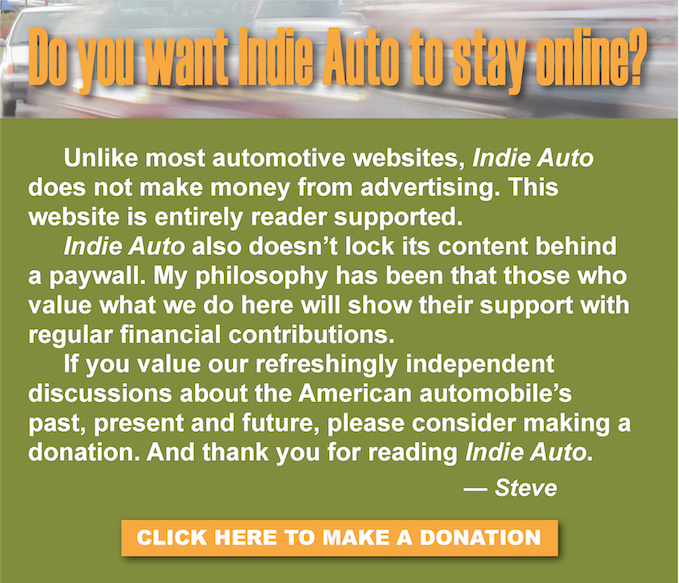
Automotive News’ April 28 front page reminded me of a daily newspaper announcing the start of a war. Rather than the usual assortment of product launches and resume-polishing profiles of auto executives, the industry journal instead ran a banner headline that shouted: “Reputation in tatters: Impact of Trump’s unpredictable actions may be hard to reverse.”
Another headline insisted, “Tariffs upend global auto supply chain, erode trust.” A pullquote added, “I think what has become very clear . . . is that this sector is not a global industry anymore.”
The tone of the front page struck me as editorializing — which I found surprising. Automotive News has typically practiced a form of journalistic objectivity so cautious and bland that it can often border on stenography.
Thus, it wasn’t surprising that the May 5 print edition had a very different tone. The banner headline read “Adapting again,” with one subhead noting that “GM to fight cost impact by boosting its U.S. footprint.” The top of the front page had two photographs of a Trump rally in Michigan. And on the op-ed page, Executive Editor Jamie Butters (2025) sounded conciliatory, noting that the “president’s de-escalation of the multifaceted tariff regime is greatly appreciated by automakers.”
For his part, President Trump was as pugilistic as usual when saying that tariff revisions would give automakers more time to source parts within the U.S: “We gave them a little bit of time before we slaughter them if they don’t do this” (Lutz, 2025).

DeLorenzo wags finger at both Trump and Detroit
Whereas Automotive News sounded like it was now waving the white flag on tariffs, Peter DeLorenzo seems to be settling in for trench warfare. However, his invective has been split between increasingly harsh criticisms of President Trump and auto industry leaders.
‘As I’ve stated previously, the current administration has the U.S.-based automakers by the balls,” DeLorenzo (2025a) argued. “Doing a redirect of plants, supply chains and suppliers, etc., is simply not feasible. There is no quick turnaround on offer, no quick fixes, no knee-jerk solutions due to the pathetic politicians currently wreaking havoc in Washington.”
Then DeLorenzo turned his attention Detroit’s leadership. “Congratulations to all of those CEOs – who are now shouting from the rooftops about how bad this all is – for signing up for four long years of this mayhem,” DeLorenzo concluded. “Let me reiterate what I’ve previously stated: You knew better, but you failed yourselves and everyone associated with this business” (2025a, original italics).
After dismissing the significance of recently announced trade deals, DeLorenzo argued that “the collective ‘Detroit’ including and especially the auto company CEOs were incredibly naïve to think that the current occupant of the Oval Office would be rational and could be reasoned with. That is nevergonnahappendotcom (2025b, original italics).
DeLorenzo’s pessimistic take about the potential for negotiating with the Trump administration strikes me as realistic — but has a fatalistic quality. He seems more interested in wagging a finger at Detroit’s leadership than in suggesting a strategy for doing an end run around Trump.

What’s the next step for tariff opponents?
This brings us back to Automotive News (2025), which at least had called for the industry to support congressional legislation that would rein in Trump’s tariff powers. But once that bill failed to pass the Senate, the trade journal has been silent on what the industry should do besides trying to negotiate a few concessions with the Trump administration and shifting supply chains to the degree that it can.
If that’s the plan, then the auto industry is likely looking at at least three more years of chaos.
The only alternative to that would be for the Democrats to gain control of both houses of Congress in the 2026 mid-term elections. Whatever else you can say about their policy stances, they could be counted on to pass anti-tariff legislation such as the bill that Automotive News endorsed. Of course, Trump could pull out his veto pen, but a mid-term walloping could plausibly push him to — at the very least — make more concessions to the industry.
The biggest weakness of this strategy is that Detroit tilts so heavily Republican that it would take a major cultural shift to support Democrats who challenge Republicans who may be simpatico on many other issues but have been unwilling to challenge Trump on tariffs.
It is looking increasingly like the auto industry can’t have it both ways. If Trump’s fixation with 19th-Century mercantilism really is a serious threat to the auto industry, then it is time to send a clear message to congressional Republicans that they need to either break with the president or lose industry support.
Share your reactions to this post with a comment below or a note to the editor.
RE:SOURCES
- Automotive News; 2025. “In our opinion: Bipartisan bill to restore tariff sanity deserves wide support.” Unsigned editorial posted March 10.
- Butters, Jamie; 2025. “Column: GM makes tariffs look survivable — but is it exceptional?” Automotive News. Posted May 2.
- DeLorenzo, Peter; 2025a. “What we’ve got here is . . . failure to communicate.” Auto Extremist. Posted May 4.
- ——; 2025b. “Welcome to the shit show.” Auto Extremist. Post May 11.
- Lutz, Hannah; 2025. “Column: Auto industry embraces tariff relief and will push for more.” Automotive News. Posted May 4.
PHOTOGRAPHY & GRAPHICS:
- Collection of the U.S. House of Representatives; 2021. “L’Installation du Nouveau President de la Republique Des Etats-Unis.” Illustration by E. A Tilly.






Be the first to comment